Mark Pickford has seen his share of climate emergencies. Now St. Albert’s emergency management manager, he was on the front lines of the 2013 High River flood, the 2016 Fort McMurray fire, and this year’s forest fire evacuation from Hay River.
To this day, he still remembers that one guy with the bird from 2013.
Then with the military, Pickford said he was at a gas station during the High River flood when a man came up to him in tears, asking if the troops could go get his bird from the attic of his house. On the day of the flood, his wife had called him in a panic, saying, “There’s a fireman at the door, there’s water coming into the basement, and they’re telling me I have three minutes to evacuate, what do I do?” The man told her to put the family’s bird in the attic and get out.
“He didn’t say anything like grab your driver’s license, grab your purse, food, clothing, car keys, nothing,” Pickford said.
“Just put that bird in the attic and go.”
That’s why having an emergency kit ready to go is so important, Pickford said — you may have only minutes to get out in the face of a wildfire or extreme weather event, so you should have the essentials ready to go.
Climate emergencies like last summer’s wildfires can force you from home and knock out power, water, and services for days. The Neighbouring for Climate guide suggests having a 72-hour emergency kit ready so you can weather those days until emergency services can get to your door.
72 hours? Try 168
Pickford said the Alberta government is now recommending residents have a seven-day emergency kit rather than a 72-hour one, as recent fires and floods have displaced people for about a week on average. Having such a kit frees up emergency responders to help those who don’t and gives them time to set up evacuation centres (as St. Albert did for the Hay River fire).
The Canadian Red Cross lists 17 essential and 13 optional items to include in a 72-hour emergency kit, including (on the optional side) duct tape, maps, plastic sheeting, and a sleeping bag.
The most essential items are food and water, said Mark Holzer, provincial emergency management manager for the Canadian Red Cross. You want at least one litre of water per person per day to drink and another two per day for hygiene — that’s nine litres total for on person for three days. For food, you want anything that’s non-perishable and easy to prepare, Holzer said — canned food and granola bars are typical. Add a manual can opener if you’re taking canned food.
“Evacuation is a very stressful and emotional time,” he noted, so don’t be afraid to throw in some comfort food.
“If you’re a big fan of soup and chili, put in soup and chili.”
The Red Cross says your kit should include any vital items (such as medications), copies of your prescriptions, a first aid kit, paper, pens, a whistle, and personal hygiene items. Crank-powered radios and flashlights, cash, and a cell phone charger are also recommended.
Be sure to include copies of vital documents such as land deeds and insurance, Pickford said — as many in Fort McMurray discovered, they and your house might be gone by the time you return. He suggests scanning these and putting them on a memory stick. If you have pets, consider pet food and other necessities.
Managing your kit
Ideally, your kit should be something you can grab and run out the door with in just a few minutes. Pickford said his family’s kit is stored in several military-style backpacks along with a box containing vital documents. Holzer stores his in a big tote that he can chuck into his truck. You can also store part of your kit in a go-bag and the rest near your car, if you’re wondering how to carry a week’s worth of water and food on your back.
While you can buy these kits pre-made, Pickford said it’s way cheaper to build them yourself. Take a list of items for the kit with you when grocery shopping and buy them over time. Remember to replace the food and drink in the kit every year or so — Pickford does so when he puts on his winter and summer tires — and store it in a clean, dry, easy-to-reach place.
Whether it lasts 24, 72, or 168 hours, Holzer and Pickford said the most important part of any emergency kit is to actually have the kit in place.
“The kit is not the end-all,” Pickford said.
“There’s always going to be help from the municipal side.”



